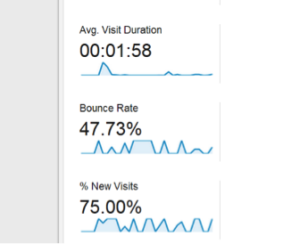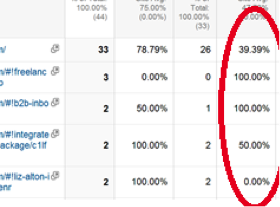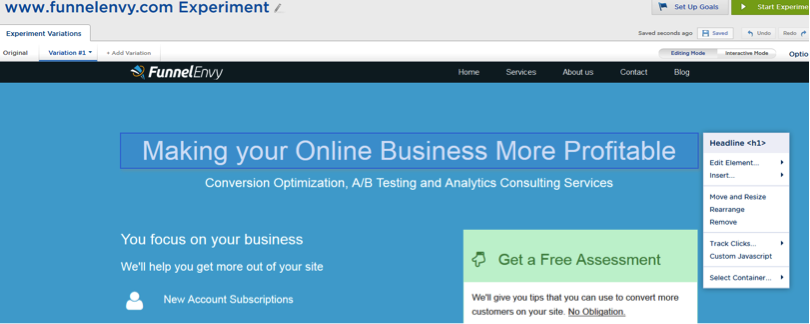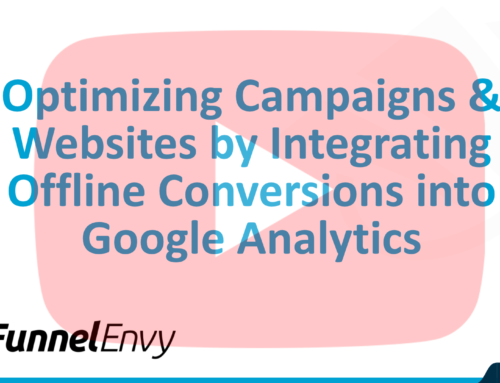If you’ve been investing in content marketing and aren’t getting the results you hoped for, you’re not alone. A recent study highlighted on Forbes suggests that 10 to 20 percent of your site’s content drives 90 percent of your web traffic, and just .5 percent of that content is what’s really drawing in over 50% of visitors.
Before you conclude that this means content marketing isn’t effective, think again: There’s significant evidence that suggests content marketing works, when your content is sufficiently optimized and part of an overall data-driven strategy. It’s all about getting to the data of what really works for your business, and using that to improve your future content writing and promotion. Here’s how to avoid this common content marketing pitfall, and significantly increase your ROI.

Photo Credit: Infomastern via Compfight cc
The Analytics Gap: It’s Affecting Content Too
Recent research from OMI suggests that companies and brands are finding that analytical skills are the biggest gap in the online marketing world. The reality is that the numbers above reflect a significant gap in content marketers’ efforts to objectively plan, measure, and adjust their content strategies to reflect the market.
The good news is that marketers are becoming savvier on the need to measure success, and the tools and techniques for doing so are becoming more sophisticated. If you’re ready to improve your content marketing analytics to find out which content is performing and which is deadweight, here’s a framework that can walk you through that process:
- Assess your content analytics plan: Review your content marketing strategy. Do you have a content analytics plan in place? If so, what specific steps, tools, and KPIs have you integrated to assess the effectiveness of each piece? Are those being enforced, reviewed at regular intervals, and integrated into a learning loop that helps you improve your strategy moving forward? The most important step is establishing that this is part of your strategy from the beginning.
- Are you measuring the right KPIs? Key performance indicators are critical to evaluating the effectiveness of your content marketing. They guide you in terms of what you’re shooting for, as well as helping to clarify whether you’re on track to meet your business objectives. The right KPIs eschew vanity metrics, and instead get into meatier things (conversions) that drive revenue and profit.
- Take stock of your toolkit: Data collection and optimization requires solid keyword data, ongoing feedback loops, and the technology that helps you mine and interpret the right facts. Do you have access to the right tools to help you manage the content analysis process?
Content Cliffs throughout the Content Lifecycle
A “content cliff” occurs when you lose readers. In content marketing, your goal with any piece of content is to create something that attracts a reader, stimulates a positive emotional response (such as improving their perception of your brand or their desire for your product), holds their attention to the end of the piece, and convinces them to take a specific action.
If you’re losing readers and failing to drive conversions, something isn’t working. Addressing breakdowns in the content marketing lifecycle requires that you identify where the problem occurs. Here are some of the most common reasons that content fails and the tools that I recommend using to help fix these issues.
Does your content match expectations?
When a reader sees an interesting title and clicks on it, there’s an expectation that the article or content that follows delivers what it promised in the teaser. When an online visitor follows a search engine recommendation, they expect the landing page to align with their keyword search. If there’s a breakdown between the reader expectations and what you deliver, you can expect to lose readers early on. These visitors won’t convert because you’re not offering what they’re looking for.
Conversion focus: Are you effectively converting visitors into readers and customers?
The tool to help you find out? Google Analytics. The easiest way to detect a mismatch between visitor expectations and the content you’re producing is to look at your bounce rate. Google Analytics offers a simple way to do that, by checking your bounce rates right on the Analytics dashboard.
Your bounce rate tells you what percentage of people land on your website, and then leave without ever checking another page. Contextualize your bounce rate with your call to action: if your main CTA takes your visitors off your site (for example, stop here and call a 1-800 number for more info or getting them to fill out a form that doesn’t take them to a confirmation page), a high bounce rate might be a good thing. But these scenarios aren’t common. More typically, you’re not retaining your site’s visitors.
At this stage, it’s time to do some advanced research using Google Analytics to find out how that bounce rate is being spread across your site. Two areas are particularly of interest – bounce rate by content type and bounce rate by traffic source.
Bounce rate by content type: In the current version of Analytics, go from Behavior > Site Analytics > Landing Pages
It’ll display your site’s top pages and you’ll be able to compare the bounce rates for specific pages. This information is gold. Which pages are sticky, and which ones are hemorrhaging visitors?
You can determine the same information by traffic referral source by going to Acquisitions > All Referrals. It’ll show you the same information. With this data, you’ll have a preliminary sense of your most effective content and your best (and worst) points of entry to the site. This drives everything from future advertising spend to content creation to which pages you’re focused on building links to.
Does your keyword research take intent into account?
Successful content marketing is built on a foundation of strong keyword research and knowing your audience. SEO is changing, but keywords are still one of the best proxies that we have to connect with an interested, organic audience. With recent changes to Google’s algorithm, SEO and keyword usage in general is moving in a more semantic direction.
Instead of searching for “red sneakers” people are searching for “where can I purchase red sneakers near me?” This means that your ability to create content that anticipates context is absolutely crucial to standing out organically. Doing so requires a deep enough understanding of your audience to catch and interpret the nuances of intent.
The tool to help you find out? InboundWriter is a powerful subscription tool (which offers a free basic version) that can help integrate both the keyword research and optimization portion of drafting content. You enter the title and text of your chosen subject. You set specific details of your content strategy (are you optimizing for traffic or search visibility?), answer questions about your audience (for example, education level), and more. From conducting in-depth keyword research to making live recommendations for improving your document as you go, it’s easy to mark your progress thanks to an overall score.
Focus on two areas:
- Focus your keyword research on discovering terms that show intent. Link that intent to your product or service. Recognize that depending on the complexity of your product or service, there may be a range of intentions that visitors have which brings them to your site. Strong content strategies will have insight into each different stream of keywords.
- Develop content that links to the buying cycle, and set up your content strategy to drive the right prospects to the right content. Someone who wants to review the basic facts about a washer is best driven to a product spec sheet. Someone searching for the best price to make a purchase now should be ending up on your online store.
Are your design or headlines losing you customers?
It’s a simple thing – but sometimes the friction or disconnect between your content and your audience isn’t the writing, video, or content itself. It’s how it’s packaged. We make constant assumptions about how well we know our customers – sometimes based on historical data, sometimes on gut instinct, sometimes on our own preferences. Design and copy are two areas where testing those assumptions can have a significant pay off.
But today’s online context evolves at the speed of light and so do reader preferences. You need real-time feedback on which iteration of your campaign is performing best. That’s where A/B testing comes in: it allows you to systematically test different headlines, designs, layouts, and more to determine which ones drive your flow of traffic toward
Conversion focus: Are your design and copy optimized for conversion?
The tool to help you find out? Optimizely is one of the numerous tools on the market to implement A/B testing. A good A/B testing tool will allow you to isolate and test different variables and measure which ones drive more conversions, lower bounce rates, and generate sales. If you’re struggling with conversions, some areas to look at for A/B testing include:
- Is your headline compelling?
- Does your page flow with a clear call to action?
- Is the call to action the central focus of the page?
- Does the language on the call to action work?
- Can your overall design be decluttered?
- Do forms require the minimal amount of information for submission?
Simple improvements in these areas can have a big impact on your overall conversion rates.
Conclusion
Content marketing was the major buzzword of 2013, and it’s promising to be the predominant strategy for marketers in 2014. But the reality is that not every piece of content achieves its objective. By working to understand which pieces of content are thriving, where your design can be tweaked for better conversions, and how to integrate advanced keyword analytics into the content creation process, you’ll be well on your way to improving your content marketing ROI. What tools are you using to improve conversion rates from your content marketing? Let me know in the comments below!








